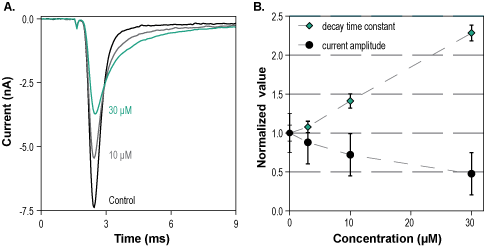Overview
Cat #:
CMN-002
Alternative Name N,N'-(1,3-phenylene)bis(2-methylbenzamide)
Lyophilized Powder yes
Source Synthetic
MW: 344.41
Purity: >97%
Effective concentration 1-100 µM.
Chemical name N,N'-(1,3-phenylene)bis(2-methylbenzamide).
Molecular formula C22H20N2O2.
Activity A novel and selective modulator of NaV1.1 channels, shown to decrease the rate of inactivation of NaV1.1 channels, and to increase neuronal excitability in hippocampal fast-spiking interneurons under weak depolarization at 30-100 µM1.
References-Activity
- Crestey, F. et al. (2015) ACS. Chem. Neurosci. 6, 1302.
Shipping and storage Shipped at room temperature. Product as supplied can be stored intact at room temperature for several weeks. For longer periods, it should be stored at -20°C.
Solubility Up to 30 mM in DMSO. Centrifuge all product preparations before use (10000 x g 5 min).
Storage of solutions Up to four weeks at 4°C or three months at -20°C.
Our bioassay
 Alomone Labs NaV1.1-Compound 3a modulates the current of human NaV1.1 channels stably expressed in HEK/293 cells.A. Superimposed traces of NaV1.1 current upon application of control solution (black), and of 10 µM (grey) and 30 µM (green) NaV1.1-Compound 3a (#CMN-002). Current was elicited by a 50 ms voltage step from the holding potential of -120 mV to 0 mV, delivered every 3 sec. B. Normalized values of the decay time constant τ (diamonds) and peak amplitude (circles) of NaV1.1 current, plotted against rising concentrations of NaV1.1-Compound 3a, demonstrate concentration dependent modulation of the two parameters. At 30 µM NaV1.1-Compound 3a decreases current amplitude, yet significantly increases the decay time constant τ (reduces the rate of inactivation).
Alomone Labs NaV1.1-Compound 3a modulates the current of human NaV1.1 channels stably expressed in HEK/293 cells.A. Superimposed traces of NaV1.1 current upon application of control solution (black), and of 10 µM (grey) and 30 µM (green) NaV1.1-Compound 3a (#CMN-002). Current was elicited by a 50 ms voltage step from the holding potential of -120 mV to 0 mV, delivered every 3 sec. B. Normalized values of the decay time constant τ (diamonds) and peak amplitude (circles) of NaV1.1 current, plotted against rising concentrations of NaV1.1-Compound 3a, demonstrate concentration dependent modulation of the two parameters. At 30 µM NaV1.1-Compound 3a decreases current amplitude, yet significantly increases the decay time constant τ (reduces the rate of inactivation).
Scientific background
NaV1.1-Compound 3a is a modulator of the NaV1.1 channel. This compound increases the activity of NaV1.1 channels although its overall impact remains moderate. It has the ability to increase neuronal excitability in fast-spiking hippocampal interneurons1.
Mutations of NaV channels are associated with a range of complex pathological conditions such as epilepsy, myotonic conditions and cardiac arrhythmias1,2. Loss-of-function mutations in mouse models has shown several phenotypes such as autistic-like behaviors, cognitive deficits, severe epilepsy, and unexpected death1.
Target NaV1.1 channels
Lyophilized Powder
For research purposes only, not for human use
Last Update: 08/01/2025
Specifications
Citations
Citations

